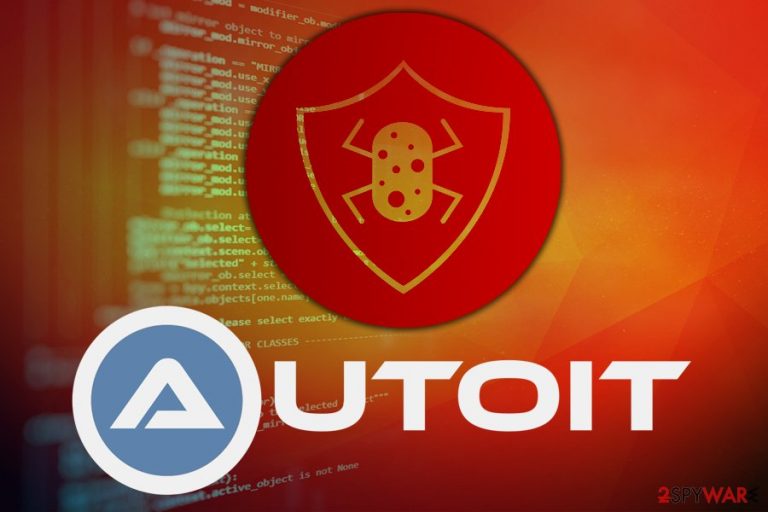AutoIt v3 script virus (Free Instructions) - 2023 update
AutoIt v3 script virus Removal Guide
What is AutoIt v3 script virus?
AutoIt v3 virus is a type of malware that uses legitimate scripting language to deliver dangerous payloads

AutoIt v3 is a programming language[1] and scripting tool that is commonly used to automate repetitive tasks in the Windows operating system. However, it can also be used to create malicious software, such as viruses and trojans. These types of malware are often distributed through email attachments or infected websites and can cause damage to a computer or steal sensitive information.
Users said that they acquired the virus after downloading such files as Michael_Buble_love.torrent.zip,[2] or infected their Flash drive with the payload from the infected computer. If you encounter any suspicious activity on your computer, there is a high chance it is contaminated and should be removed with the help of our guide – so please read on. The AutoIt v3 script virus needs to be removed from the machine because this infection can damage the machine significantly.
The infection can be spread via the prepacked installers, infected files and malicious sites. Spam emails can be sent out with malicious data and the code for the malware. It might happen due to the breaches of databases with client credentials. This happens too often, so be careful when you hear about anything possibly linked to your account.
| Name | AutoIt v3 script virus |
| Type | Malware |
| Distribution | Infected files, unsafe websites, repacked installers, spam emails, etc. |
| Symptoms | Vary, depending on the payload |
| Based on | AutoIt scripting language |
| Related files | Michael_Buble_love.torrent.zip, Autoitv3script.exe, WinddowsUpdater.exe |
| Elimination | Use reputable security software |
| Optimization | To restore Windows registry and fix damage to the system, use PC repair software FortectIntego |
Because AutoIt v3 script virus is not a specific malware but a script, it can carry many different payloads, depending on what the hacker programmed it to be. Reddit[3] user reported that his encounter with malware started when his Flash stick got contaminated.
The initial infection was loaded into a suspicious file under the name of AutoIt v3 script.exe, and after the execution, the user noticed thousands of files being created on the hard drive.
In another instance, a user tried to download a torrent file that actually had a .zip appendix at the end. Thus, users who download movies or other media from torrent networks should be cautious.
Symptoms of the infection can vary, as it all depends on the goals of the hacker who wrote the malicious script. However, you might experience the following signs:
- Frequent errors and BSODs;
- Redirects to suspicious websites;
- Additional programs installed without warning;
- Increased CPU usage;
- Stuttering HD video or games;
- Windows registry keys altered (not immediately visible);
- Multiple entries created on the machine, etc.
Unfortunately, such is often designed not to produce any symptoms at all, especially if it was created for data harvesting purposes. Thus, you should remove AutoIt v3 script virus with the help of reputable security software and then scan the PC with FortectIntego in order to make sure all virus damage is eliminated.
While AutoIt v3 script virus removal might be completed manually, experts highly discourage such actions. Those who do not possess in-depth computer knowledge should rely on professional tools that would detect malware automatically.

Something to take into consideration when considering improving computer safety
Malware, such as trojans, worms, ransomware, rootkits,[4] and other dangerous threats can be acquired on the internet, and hackers don't even have to put much effort into its distribution, in some cases. However, most of the intrusion methods require victims' interaction in one way or another, so it all comes down to the precaution measures, and time one is prepared to put into cybersecurity.
First of all, rule number one is acquiring powerful security software. One can argue whether or not paid AV solutions are better than free ones, but many researchers claim that non-free versions provide overall better protection from threats.
After installing reputable security software, users should also pay attention to spam emails, as they can carry parasites inside malicious attachments or include links to malware's payload. Thus, do not casually open documents, PDF, text, or similar files that are attached to the email coming from an unknown source.
Another important step to protect yourself from malware is software updates. Security patches fix bugs that would otherwise allow attackers to use exploit kits and infect vulnerable machines with malware.
Eliminate AutoIt v3 script virus from your computer
Looking at how the virus is constructed, it will mostly be a payload designed to steal data, mine crypto, spread on the network, lock up files, or does other tasks that are harmful to the victim. Such viruses usually use sophisticated obfuscation, and persistence techniques, so manual AutoIt v3 script virus removal might be almost impossible.
Instead, we suggest you download and install reputable security software that is capable of detecting malware. You can try to remove AutoIt v3 script virus with SpyHunter 5Combo Cleaner or Malwarebytes. Note that some viruses interfere with AV engines, so entering Safe Mode with Networking might be necessary. You will find all the instructions below. We also recommend checking browsers – removing suspicious extensions and cleaning browser caches.
After you terminate the threat, you should use FortectIntego or similar software to repair virus damage and restore the Windows registry. These pieces can be damaged or corrupted, so your device cannot run properly. Make sure to double-check and remove the infection fully.
You may remove virus damage with a help of FortectIntego. SpyHunter 5Combo Cleaner and Malwarebytes are recommended to detect potentially unwanted programs and viruses with all their files and registry entries that are related to them.
Getting rid of AutoIt v3 script virus. Follow these steps
Remove from Google Chrome
Delete malicious extensions from Google Chrome:
- Open Google Chrome, click on the Menu (three vertical dots at the top-right corner) and select More tools > Extensions.
- In the newly opened window, you will see all the installed extensions. Uninstall all the suspicious plugins that might be related to the unwanted program by clicking Remove.

Clear cache and web data from Chrome:
- Click on Menu and pick Settings.
- Under Privacy and security, select Clear browsing data.
- Select Browsing history, Cookies and other site data, as well as Cached images and files.
- Click Clear data.

Change your homepage:
- Click menu and choose Settings.
- Look for a suspicious site in the On startup section.
- Click on Open a specific or set of pages and click on three dots to find the Remove option.
Reset Google Chrome:
If the previous methods did not help you, reset Google Chrome to eliminate all the unwanted components:
- Click on Menu and select Settings.
- In the Settings, scroll down and click Advanced.
- Scroll down and locate Reset and clean up section.
- Now click Restore settings to their original defaults.
- Confirm with Reset settings.

Remove from Microsoft Edge
Delete unwanted extensions from MS Edge:
- Select Menu (three horizontal dots at the top-right of the browser window) and pick Extensions.
- From the list, pick the extension and click on the Gear icon.
- Click on Uninstall at the bottom.

Clear cookies and other browser data:
- Click on the Menu (three horizontal dots at the top-right of the browser window) and select Privacy & security.
- Under Clear browsing data, pick Choose what to clear.
- Select everything (apart from passwords, although you might want to include Media licenses as well, if applicable) and click on Clear.

Restore new tab and homepage settings:
- Click the menu icon and choose Settings.
- Then find On startup section.
- Click Disable if you found any suspicious domain.
Reset MS Edge if the above steps did not work:
- Press on Ctrl + Shift + Esc to open Task Manager.
- Click on More details arrow at the bottom of the window.
- Select Details tab.
- Now scroll down and locate every entry with Microsoft Edge name in it. Right-click on each of them and select End Task to stop MS Edge from running.

If this solution failed to help you, you need to use an advanced Edge reset method. Note that you need to backup your data before proceeding.
- Find the following folder on your computer: C:\\Users\\%username%\\AppData\\Local\\Packages\\Microsoft.MicrosoftEdge_8wekyb3d8bbwe.
- Press Ctrl + A on your keyboard to select all folders.
- Right-click on them and pick Delete

- Now right-click on the Start button and pick Windows PowerShell (Admin).
- When the new window opens, copy and paste the following command, and then press Enter:
Get-AppXPackage -AllUsers -Name Microsoft.MicrosoftEdge | Foreach {Add-AppxPackage -DisableDevelopmentMode -Register “$($_.InstallLocation)\\AppXManifest.xml” -Verbose

Instructions for Chromium-based Edge
Delete extensions from MS Edge (Chromium):
- Open Edge and click select Settings > Extensions.
- Delete unwanted extensions by clicking Remove.

Clear cache and site data:
- Click on Menu and go to Settings.
- Select Privacy, search and services.
- Under Clear browsing data, pick Choose what to clear.
- Under Time range, pick All time.
- Select Clear now.

Reset Chromium-based MS Edge:
- Click on Menu and select Settings.
- On the left side, pick Reset settings.
- Select Restore settings to their default values.
- Confirm with Reset.

Remove from Mozilla Firefox (FF)
Remove dangerous extensions:
- Open Mozilla Firefox browser and click on the Menu (three horizontal lines at the top-right of the window).
- Select Add-ons.
- In here, select unwanted plugin and click Remove.

Reset the homepage:
- Click three horizontal lines at the top right corner to open the menu.
- Choose Options.
- Under Home options, enter your preferred site that will open every time you newly open the Mozilla Firefox.
Clear cookies and site data:
- Click Menu and pick Settings.
- Go to Privacy & Security section.
- Scroll down to locate Cookies and Site Data.
- Click on Clear Data…
- Select Cookies and Site Data, as well as Cached Web Content and press Clear.

Reset Mozilla Firefox
If clearing the browser as explained above did not help, reset Mozilla Firefox:
- Open Mozilla Firefox browser and click the Menu.
- Go to Help and then choose Troubleshooting Information.

- Under Give Firefox a tune up section, click on Refresh Firefox…
- Once the pop-up shows up, confirm the action by pressing on Refresh Firefox.

After uninstalling this potentially unwanted program (PUP) and fixing each of your web browsers, we recommend you to scan your PC system with a reputable anti-spyware. This will help you to get rid of AutoIt v3 script registry traces and will also identify related parasites or possible malware infections on your computer. For that you can use our top-rated malware remover: FortectIntego, SpyHunter 5Combo Cleaner or Malwarebytes.
How to prevent from getting malware
Do not let government spy on you
The government has many issues in regards to tracking users' data and spying on citizens, so you should take this into consideration and learn more about shady information gathering practices. Avoid any unwanted government tracking or spying by going totally anonymous on the internet.
You can choose a different location when you go online and access any material you want without particular content restrictions. You can easily enjoy internet connection without any risks of being hacked by using Private Internet Access VPN.
Control the information that can be accessed by government any other unwanted party and surf online without being spied on. Even if you are not involved in illegal activities or trust your selection of services, platforms, be suspicious for your own security and take precautionary measures by using the VPN service.
Backup files for the later use, in case of the malware attack
Computer users can suffer from data losses due to cyber infections or their own faulty doings. Ransomware can encrypt and hold files hostage, while unforeseen power cuts might cause a loss of important documents. If you have proper up-to-date backups, you can easily recover after such an incident and get back to work. It is also equally important to update backups on a regular basis so that the newest information remains intact – you can set this process to be performed automatically.
When you have the previous version of every important document or project you can avoid frustration and breakdowns. It comes in handy when malware strikes out of nowhere. Use Data Recovery Pro for the data restoration process.
- ^ AutoIt. Wikipedia. The Free Encyclopedia.
- ^ AutoIT V3 script. Microsoft. Community.
- ^ Autoit v3 script.exe - The shortcut virus/WinddowsUpdater.exe. Reddit. Discussion website.
- ^ Rootkit. Techopedia. Where Information Technology and Business Meet.
